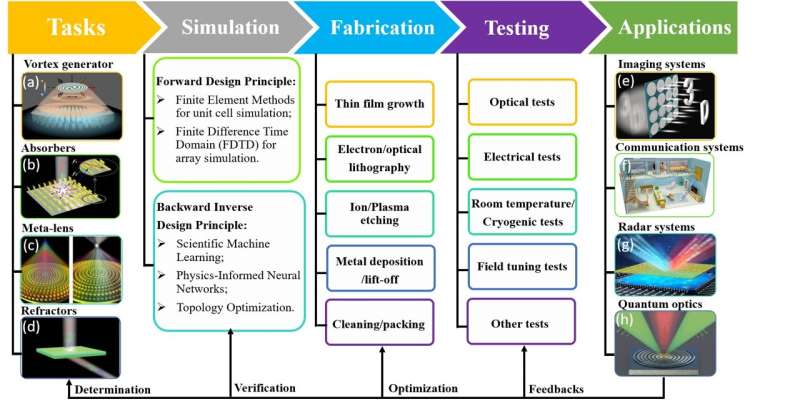This article has been reviewed according to Science X's editorial process and policies. Editors have highlighted the following attributes while ensuring the content's credibility:
fact-checked
peer-reviewed publication
trusted source
proofread
Reviewing recent advances in metasurface design with intelligent optimization methods

Electromagnetic (EM) wave front modulation has important significance in both scientific research and industrial applications. However, conventional dielectric materials have limited choices of dielectric constants. In addition, large dimensions and complex shapes are required to accumulate enough propagating phase to realize targeted functions.
In recent years, two-dimensional (2D) planar materials, known as metasurfaces, have solved challenging problems encountered by traditional optical devices. Metasurfaces have artificially tunable EM responses. A traditional metasurface design relies on the forward prediction methods. Finite Element Methods or Finite Difference Time Domain Methods are used to predict the optical properties.
Normally, a unit cell is simulated with a periodic boundary. Then more unit cells are combined to form a large area system. Such a process is time-consuming, and the designed meta-atoms have difficulty achieving ideal optical responses. Due to the use of periodic boundary conditions in meta-atom design and aperiodic boundary conditions in the array simulation process, the mutual coupling between different meta-atoms causes unavoidable inaccuracy.
In a recent review paper published in Light Science & Application, a team of scientists from Delft University of Technology, The Netherlands, summarize an intelligent metasurface design combining forward and reverse algorithms, offering a solution to overcome the problems encountered by traditional metasurfaces.
Compared with traditional optimization algorithms, machine learning can predict unknown problems by learning complex relationships between model variables and optical properties from large known datasets. This strategy can significantly reduce the computational time of a metasurface design by providing a more comprehensive and systematic optimization for metasurface properties.
Additionally, by using deep optics and photonics theory, (e.g., rigorous coupled wave analysis, RCWA) with advanced optimization algorithms (e.g., automatic differentiation, AD), parameters are adjusted and re-evaluated to reach the final goal more efficiently. This method is called topology optimization. It shows significant advantages in terms of physical accuracy, computational time, and degrees of freedom.
The scientists summarize, "The basic principle flowchart of machine learning approach for metasurface design is as follows: for a simple structure, data sets of EM response can be obtained using forward solver algorithms with a variety of parameter combinations as an input. These data sets can then be used to train a deep neural network, which can calculate the EM response when provided with the input."
"This is referred to as a forward network. Through the same training process, an inverse network is also obtained. The inverse network differs in that the input is the desired response, and the output is the geometry parameters of the structure. The optimized solutions can also be evaluated using forward solver algorithms to determine if the response is acceptable"
"The basic principle for physics-informed neural networks is to add information on the physics laws, such as Maxwell's equations or some other partial differential equation (PDE), into neural networks. The operation can be realized by incorporating PDE governing data set into a loss function of framework."
"A meta-atom structure, which has a complex design and multiple parameters, results in a greater degree of freedom compared to previous methods. Data sets are obtained by simulating the structure through a forward solver, but with the incorporation of physics laws such as Maxwell's Equations and EM boundary conditions into the neural networks, the required data set size is reduced, leading to a significant reduction in computational time. The remaining design process is consistent with the machine learning method, " they added.
The scientists continue, "The methods above can be extended to the design for other optical devices, such as photonic crystals, optical cavities, and integrated photonic circuits. Intelligent metasurfaces are a rapid development direction and have important application prospects in several new revolutionary fields, especially in the field of quantum optics."
More information: Wenye Ji et al, Recent advances in metasurface design and quantum optics applications with machine learning, physics-informed neural networks, and topology optimization methods, Light: Science & Applications (2023). DOI: 10.1038/s41377-023-01218-y
Journal information: Light: Science & Applications
Provided by Chinese Academy of Sciences





















